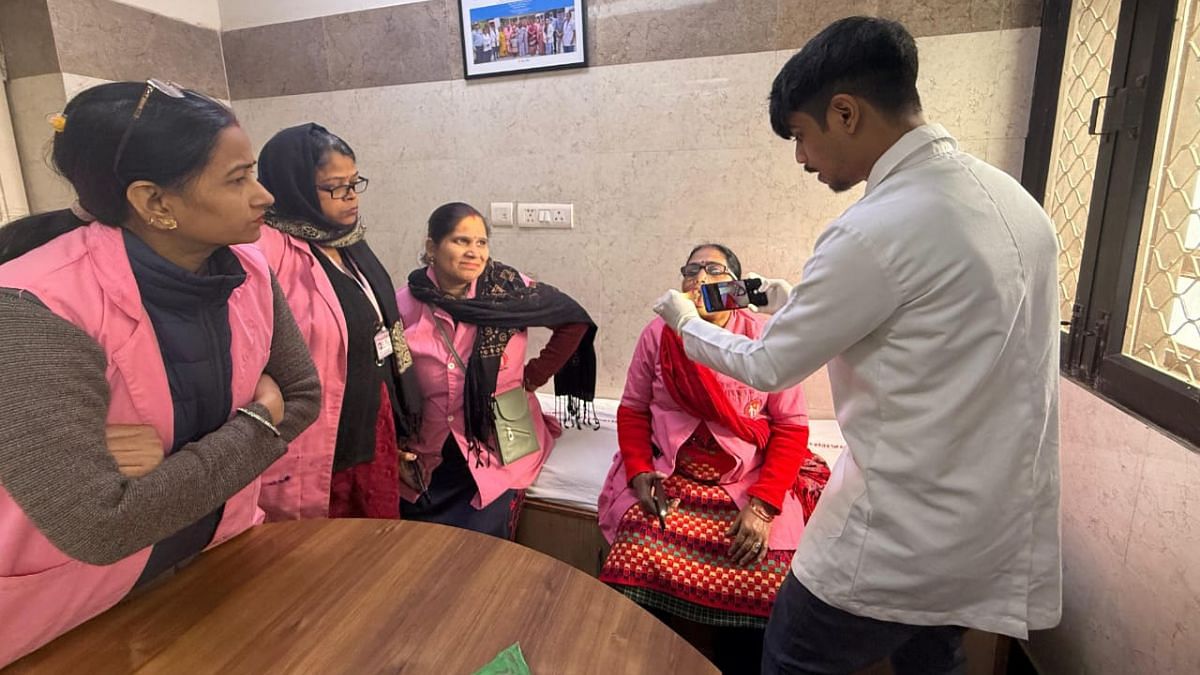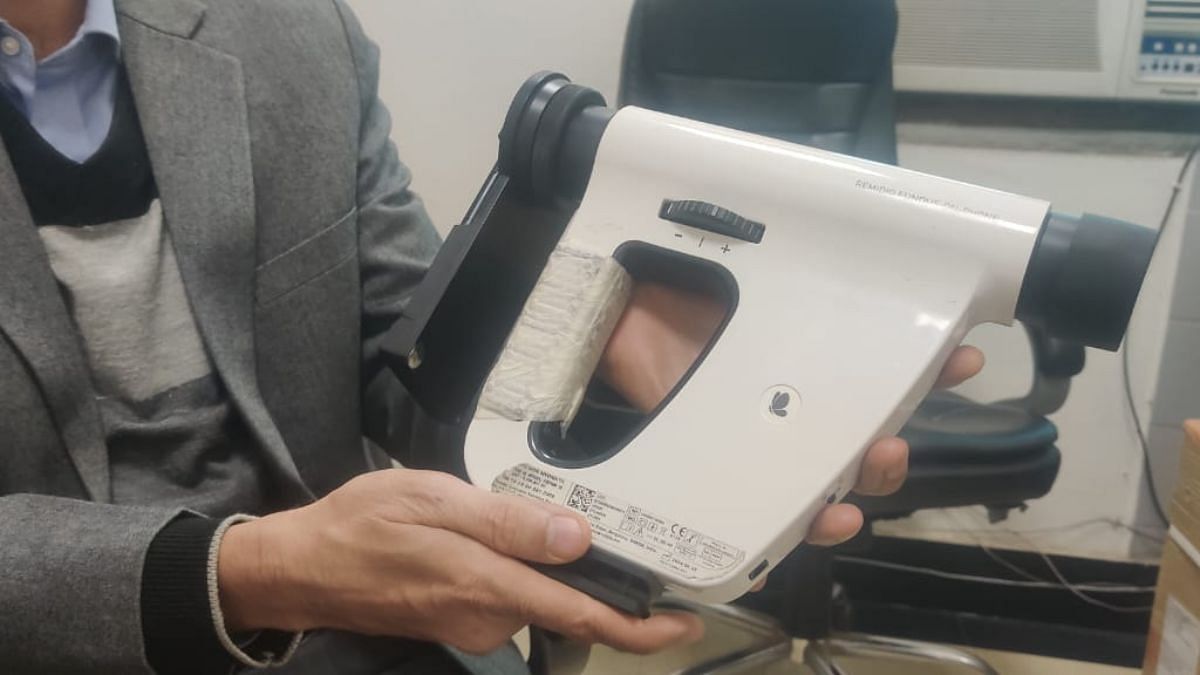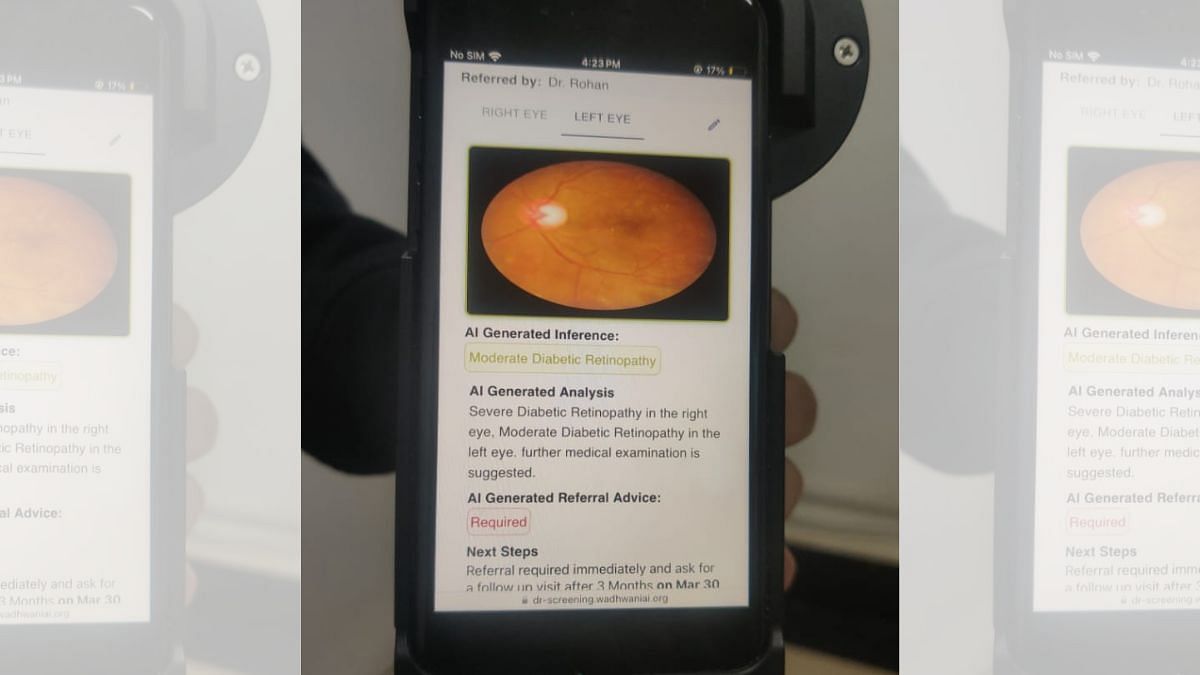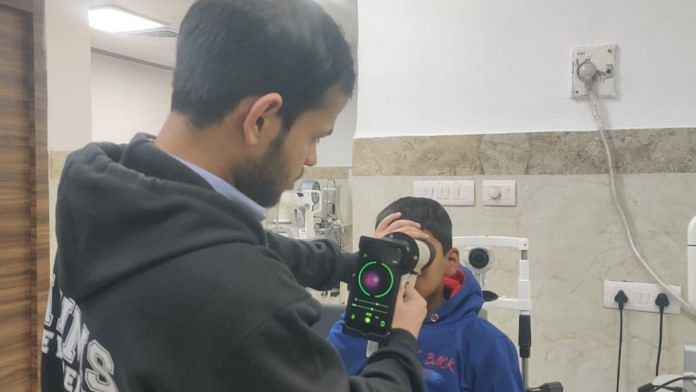New Delhi: A few photographs taken from a smartphone could soon mean the difference between life and death.
Healthcare workers may be able to assess the risk of oral cancer, recommend next steps and even deliver early life-saving interventions, all from just a handful of photos of a patient’s oral cavity and the help of cutting-edge artificial intelligence (AI) technology.
Innovations like the Arogya Aarohan app, created by All India Institute of Medical Sciences (AIIMS) Delhi in collaboration with The Indian Institute of Science (IISc) Bangalore are turning low-cost smartphones into life-saving diagnostic tools.
The app is part of a Rs 300-crore initiative spearheaded by AIIMS in partnership with Indian Institute of Technology (IIT) Delhi and 23 other institutions to integrate AI into healthcare in a bid to reduce pressure on healthcare systems, especially in rural areas that face a shortage of professional experts.
Together, they are leading a Centre of Excellence that focuses on five key areas under national health programmes: cancer screening (breast, oral and cervical cancers), chronic disease management, visual impairment and blindness, infectious diseases with antimicrobial resistance, and maternal and child health.
“This is a public health-focused project aimed at improving the efficiency of India’s national healthcare programmes,” said Dr Krithika Rangarajan, Associate Professor of Radiology at the Institute-Rotary Cancer Hospital (IRCH), AIIMS Delhi, and lead of the AI team at AIIMS.
“Typically, AI is developed in silos, which limits its acceptance. Instead of starting with AI, we began by analysing the country’s healthcare system, recognising that existing systems are hard to change. For each programme, we identified inefficiencies and determined where AI could make the most impact,” she told ThePrint.
The Arogya Aarohan application to assess the risk of oral cancer is just one of the few AI-driven initiatives aimed at detecting diseases like tuberculosis, diabetic retinopathy, breast cancer, leprosy and sexually transmitted infections.

Doctors say that the Arogya Aarohan app developed by ARTPARK and IISc Bengaluru and other AI-driven tools are still undergoing testing for early disease detection. AI has not replaced doctors; instead, it serves as an aid to the Clinical Decision Support System (CDSS), helping doctors manage high patient loads and address unique or rare clinical representations.
Also read: 92% of rural households’ hospitalisation costs are out of pocket, 77% for urban families—govt data
How the app works
Healthcare workers enter a patient’s details, including tobacco and alcohol consumption history, and answers to some simple yes-or-no questions about symptoms through the app. They then upload eight to nine photos of the oral cavity taken in a clockwise sequence.
The app analyses the data using AI technology, providing a risk assessment of oral cancer labelled as “suspicious” or “non-suspicious”, along with the percentage of suspicion.
Remote specialists review this information and recommend the next steps such as immediate referral to a tertiary care hospital for cancer treatment, a biopsy at a nearby district hospital, routine follow-up for low-risk lesions, or continued monitoring with tobacco cessation counselling. At the moment, this is not done in real-time.
Healthcare workers have conducted trials for the Arogya Aarohan app on almost 2,400 patients at AIIMS and its tertiary care centres.
“It is still in the developmental mode but gives good accuracy and is set to grow with more clinical trials,” said Dr Deepika Mishra, Additional Professor, Oral Pathology and Microbiology, AIIMS.
It could also help reduce turnaround times by minimizing screening and diagnostic delays, aligning with one of the core principles of the ‘India AI Mission.’ This initiative aims to create a national-level, quality-graded dataset that can be used to train, test, and validate AI algorithms for cancer screening. This effort is part of the Medical Information and Imaging Datasets (MIDAS) for India project, a collaboration between the Indian Council of Medical Research (ICMR), IISc Bengaluru, and the AIIMS Delhi.
Scalable, inclusive and last-mile-focused
Most AI-driven healthcare projects at AIIMS are still in the trial phase and are focused on primary healthcare centres in rural areas.
Efforts are underway to conduct trials at the community level and train ASHA and Anganwadi workers to support these initiatives.

Doctors at AIIMS believe this AI-based approach will not only help in early diagnosis but also reduce the need for patient referrals to larger hospitals, reducing pressure on the healthcare system.
With India’s doctor-patient ratio standing at 1:836 as of July 2024, which is better than the WHO standard of 1:1000, AIIMS doctors say these efforts can help bridge the healthcare gap in underserved areas.
Wadhwani AI—an independent non-profit institute developing AI-based solutions for underserved communities in developing countries—is also collaborating with AIIMS to create AI-based solutions for chest radiography and diagnose diseases like tuberculosis, diabetic retinopathy, breast cancer, leprosy and sexually transmitted infections.
“We aim to develop scalable AI-driven solutions for public health, leveraging India’s data and medical expertise to address last-mile healthcare challenges,” Nakul Jain, Director, Products, Wadhwani AI, told ThePrint.
“Our focus includes building diagnostic, predictive, and decision-making tools for deployment in remote areas, upskilling healthcare workers, and integrating these solutions with national health programmes to enhance accessibility and public awareness,” he added.
Dr Rangarajan underscores that “implementation is a huge challenge, which we often underestimate”.
Reflecting on the initiative, she said, “One major learning is the importance of extensive testing before deployment. Differences in populations, equipment, and methods of data capture—such as between AIIMS and peripheral centers—can lead to significantly varied results.”
She further explained, “We tend to think the problem is solved when we get results in the lab. But if building the model is 80 percent of the work, the remaining 20 percent—implementation—is another 80 percent worth of effort. Understanding and addressing on-ground challenges is key to making a real difference.”
Dr Rangarajan also mentioned that currently, the primary application is as “an assistant to a senior doctor”, with test deployments already in place that integrate seamlessly into existing workflows.
However, she highlights that transitioning to advanced use cases, such as enabling a junior doctor to perform at the level of a senior doctor or assisting ASHA workers, will require more time and development.
More trials and screenings for greater accuracy
The Arogya Aarohan app for oral cancer detection isn’t the only cutting-edge tool that AIIMS is developing.
It has also developed another AI-powered app for the early detection of diabetic retinopathy—a condition caused by high blood sugar levels that can lead to swelling, bleeding in the retina and potential vision loss. This app demonstrated an accuracy of 90-95 percent.
Dr Rohan Chawla, Additional Professor of Ophthalmology at AIIMS and a key member of the project, however, noted that this accuracy level was achieved during hospital-based trials.
Community-level screenings are being conducted starting with AIIMS vision centres in Delhi, where approximately 2,500 people have been screened as part of ongoing clinical trials.
The AI-driven solution for detection of diabetic retinopathy involves using Fundus-on-Phone (FOP) NM-10, a portable, smartphone-based non-mydriatic retinal camera developed by Bengaluru-based Remidio Innovative Solutions Pvt. Ltd. This specialised handheld device enables high-resolution imaging of the retina by positioning one end near the patient’s eye while the healthcare provider adjusts the focus using a live feed displayed on the smartphone screen.
In partnership with Aravind Eye Care System, Sankara Eye Foundation, and Dr Shroff’s Charity Eye Hospital, Remidio has expanded the reach of this technology. According to the company’s statement, these partnerships empower ophthalmologists and mid-level healthcare personnel to conduct screenings, triage cases, and optimize specialist schedules—significantly enhancing efficiency and outcomes in resource-limited settings.

Once a clear image is captured, the AI model analyses it and provides diagnostic results on the extent of the condition such as “severe diabetic retinopathy” or “moderate diabetic retinopathy”, along with referral recommendations for further treatment.

According to a Lancet study, India has the world’s largest population of diabetic patients, with 21.2 crore people affected by it. “It is a preventable cause of blindness. So, the earlier it is detected and addressed, the better the outcomes,” Dr Chawla added.
Another AI innovation focuses on detecting oral cancers among tobacco users.
A device developed by a team led by IIT Delhi professors combines four advanced techniques to identify precancerous and cancerous areas in the mouths of tobacco users. This multi-modal device functions as a clinical support tool that can be used by semi-skilled healthcare workers and even non-medical personnel.
The device employs autofluorescence, fluorescence (with dye) and spectroscopy techniques to use light at specific wavelengths to identify normal and abnormal tissues. AI-driven algorithms then analyse the collected data and generate a detailed report for the patient.
It is currently being validated by teams at AIIMS Delhi, the National Cancer Institute in Jhajjar, and their outreach areas. So far, the device has screened over 500 patients.
The device has already been patented, and further design improvements are underway in collaboration with start-ups, explained Dr Varun Surya, Assistant Professor in Oral Pathology at AIIMS.
AI algorithm established, awaiting trials
AIIMS doctors are also working to use AI technology for early detection of tuberculosis.
Dr Neeraj Nischal from the Department of Medicine at AIIMS, Delhi, explained that if patients become infected before doctors can diagnose them, they often unknowingly spread the infection to others—whether at home, in the workplace or, in the case of children, at school.
“This happens before we can intervene to contain it. With the help of new AI technologies, we aim to identify infections earlier and curb their spread effectively. Unless we do that, controlling TB will be a difficult task,” he added.
As part of its efforts for early tuberculosis detection, AIIMS is testing a cough-analysis app to differentiate tuberculosis (TB) coughs from other conditions like allergies, chronic obstructive pulmonary disease (COPD), asthma or pneumonia.
“The technology has the potential to enable early TB detection using just a recorded cough sound through an app, followed by targeted investigations to confirm the diagnosis,” said Dr Nischal.
He added that both the app and its software algorithm are already in place, and AIIMS is now validating the results on a larger scale.
“We aim to test its effectiveness in outpatient departments (OPDs) and chest clinics. Following that, we plan to extend its implementation to district levels and eventually to grassroots settings to ensure it can identify cases effectively at all levels,” he said.
The app is expected to be rolled out within 9 to 12 months.
This innovative approach, according to Dr Nischal, aims to streamline TB screening by reducing reliance on methods such as mobile X-rays, which involve radiation exposure, and costly molecular tests like GeneXpert (a diagnostic test for TB) and TrueNat (a chip-based device for diagnosis of infectious diseases).
To improve the TB screening process, another AI-based technology is being developed focused on chest radiographs or X-rays—where the app will distinguish between normal and abnormal X-rays that might also help in diagnosing TB.
Dr Ashu Bhalla, MD, Department of Radiology at AIIMS Delhi, explained that two AI models have been developed. The first performs binary classification, identifying radiographs as either “normal” or “abnormal”, allowing normal cases to be reassured and sent home.
The second model further analyses abnormalities, identifying features like fluid infusion or consolidation, a condition in the lungs that appears on a chest X-ray or CT scan as a white area that obscures the blood vessels and airway walls.
“Combined with clinical expertise, these insights help refine diagnosis,” Dr Bhalla explained.
The AI tool connects to the X-ray machine where the images are generated and then sent to a central cloud for analysis. Trials have only been conducted within AIIMS because it already has a PACS (Picture Archiving and Communication System) in place, storing all data digitally since 2012, she said.
However, deployment in locations without PACS is still in process. “The idea is to connect the tool directly to the computer linked to the X-ray machine. Since all the data is now digital, the tool will analyse the images and return the report to that computer. That’s the format we’re working towards,” Dr Bhalla told ThePrint.
The AI model has been test-deployed, processing 500,000 X-rays every few months, with reports manually verified. The model currently matches commercial standards and is being designed for free use in public health systems, especially in district hospitals.
However, Dr Bhalla clarified that AI hasn’t replaced doctors. “We haven’t yet replaced a doctor’s decision with AI. It’s still in the test deployment phase. AI has not yet surpassed the radiologist’s opinion.”
India has pledged to achieve a TB-free country by 2025. According to the Ministry of Health and Family Welfare, the TB incidence rate decreased by 17.7 percent, from 237 per 100,000 in 2015 to 195 per 100,000 in 2023. Similarly, TB-related deaths have declined by 21.4 percent, from 28 per 100,000 in 2015 to 22 per 100,000 population in 2023.
Tuberculosis is of two types: pulmonary TB, which infects the lungs, and extrapulmonary TB, which affects the organs outside of the lungs. Currently, pulmonary TB has been the primary focus of the AI project.
Using the central government’s eSanjeevani scheme
AIIMS is also in the early stages of developing AI-driven projects for leprosy and sexually transmitted infections (STIs), with algorithms still in the works.
Dr Somesh Gupta, Professor in the Department of Dermatology and Venereology at AIIMS, outlined the long-term goals of the project.
For leprosy, the aim is to create a decision support system that differentiates it from other skin conditions and guides treatment. The smartphone-based app will gather patient data through simple yes/no answers and images of skin lesions.
At the same time, to address the stigma attached to sexually transmitted infections (STIs), Dr Gupta explained that a patient-centric AI-enabled app is in the process of being developed that will allow users to assess their symptoms interactively.
The app, he added, will guide the patient through a brief question-and-answer process and, if they choose, include an image of their condition.
Based on this input, the app will assess the severity of the issue and connect the patient to a specialist if necessary.
If the AI detects a potential STI, it will offer telemedicine access through the central government’s eSanjeevani initiative for immediate consultation.
“Additionally, the app will include voice counseling, educating users on sexual health practices and how to prevent the transmission of infections, ensuring that all users receive support, regardless of whether they have an STI or not,” Dr Gupta told ThePrint.
Challenges
However, the road ahead isn’t easy with doctors facing significant challenges such as image quality and language barriers.
According to doctors, one major challenge is ensuring that the technology works effectively in remote areas, where hospital equipment and other facilities such as Internet access may be poor.
Dr Chawla said that capturing high-quality images is a significant hurdle. Moreover, the cost of advanced cameras is significant and people taking the photos need proper training.
“We will continue refining the system and releasing updated versions to improve accuracy. This will be an ongoing process,” he said.
During a training session for ASHA workers at one of AIIMS’s primary healthcare centres in Pitampura, they faced some difficulties with the technology.
Although different phones were provided, the Arogya Aarohan app is currently only available in English, which poses a language barrier.
Despite this, the workers remained confident that they would become more proficient in using the technology with time.
Dr Rangarajan highlighted that some initiatives are being adapted for regional languages to improve accessibility. “For instance, our breast cancer risk assessment work was developed in Hindi, and even tailored to the Haryanvi dialect for deployment in Jhajjar.”
“The patient interactions and conversations during this initiative were conducted in Haryanvi, ensuring better communication and understanding at the local level,” she said.
This is an updated version of the report
(Edited by Sugita Katyal)






